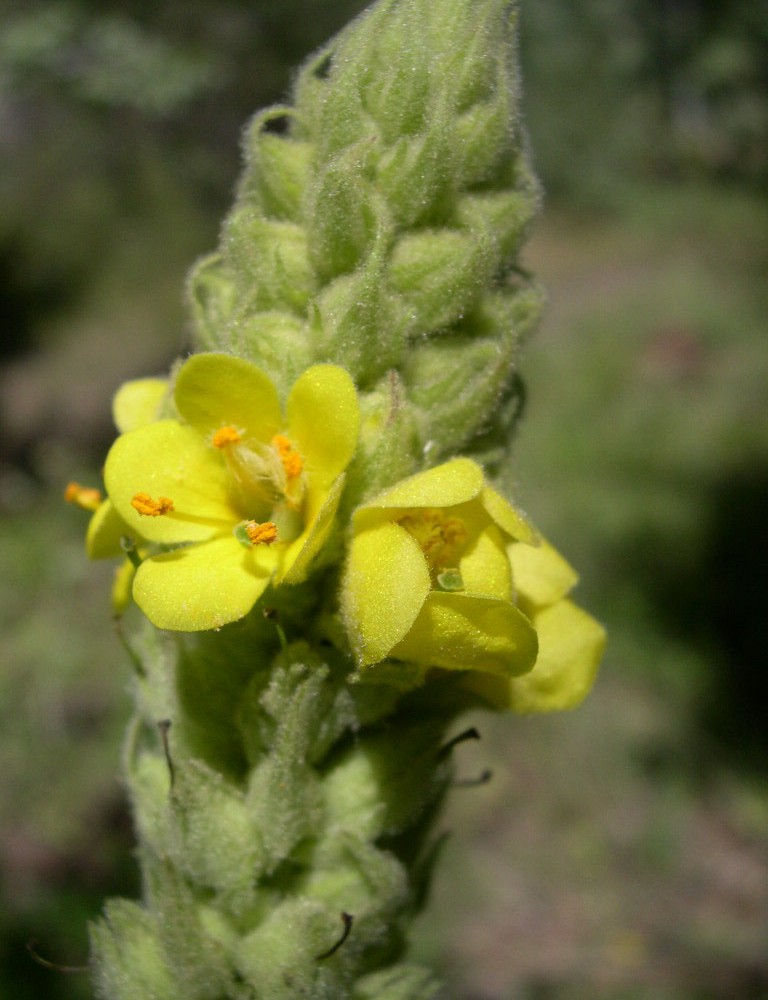Common mullein
(Verbascum thapsus thapsus)

Description
Verbascum thapsus thapsus, commonly known as great mullein, is a biennial plant belonging to the Scrophulariaceae family. It is a native plant of Europe, but it has also been introduced to other regions such as North America, Asia, and Africa, where it is now considered invasive in some areas. The plant has a long history of medicinal use and is also commonly used as an ornamental plant in gardens. In this article, we will explore the characteristics, distribution, cultivation, and uses of Verbascum thapsus thapsus in detail. Characteristics Verbascum thapsus thapsus is a biennial herbaceous plant that can grow up to 6 feet (1.8 m) tall. In its first year, the plant produces a basal rosette of large, soft, velvety leaves that can be up to 2 feet (0.6 m) long and 1 foot (0.3 m) wide. In the second year, a tall, sturdy stem emerges from the center of the rosette, bearing numerous yellow flowers in a dense spike-like inflorescence that can be up to 8 inches (20 cm) long. The flowers have five petals and are about 1 inch (2.5 cm) in diameter. They are arranged in a spiral pattern around the stem, and the lower ones open first. The leaves and stems of Verbascum thapsus thapsus are covered with dense, soft hairs that give the plant a velvety texture. The hairs are thought to help protect the plant from herbivores and from water loss through transpiration. The plant has a taproot that can reach depths of up to 6 feet (1.8 m), which helps it to survive in dry and poor soil conditions. Distribution Verbascum thapsus thapsus is native to Europe and western Asia, but it has been introduced to other regions such as North America, Asia, and Africa. In these regions, it is often considered invasive and can grow in disturbed habitats such as roadsides, fields, and waste places. The plant prefers dry, well-drained soils and full sun, but it can also tolerate partial shade. Cultivation Verbascum thapsus thapsus can be propagated from seeds or by division of established plants. The seeds can be sown in early spring or fall, and they require light to germinate. The young plants should be spaced about 18 inches (45 cm) apart to allow for their large size at maturity. The plant prefers well-drained soils and full sun, but it can also tolerate partial shade. It is a hardy plant that can tolerate drought and poor soil conditions, but it may benefit from occasional watering and fertilization. Verbascum thapsus thapsus is a biennial plant, meaning that it completes its life cycle in two years. In the first year, it produces a basal rosette of leaves, and in the second year, it produces a tall stem with flowers. Uses Verbascum thapsus thapsus has a long history of medicinal use, dating back to ancient Greece and Rome. The plant has been used to treat a variety of ailments, including respiratory infections, skin conditions, and gastrointestinal problems. The leaves and flowers of the plant contain mucilage, which has a soothing effect on the mucous membranes, making it useful in the treatment of coughs, sore throats, and bronchitis. The plant has also been used topically to treat skin conditions such as burns, wounds, and eczema. The leaves and flowers are steeped in oil to create a soothing and healing ointment.
Taxonomic tree:







